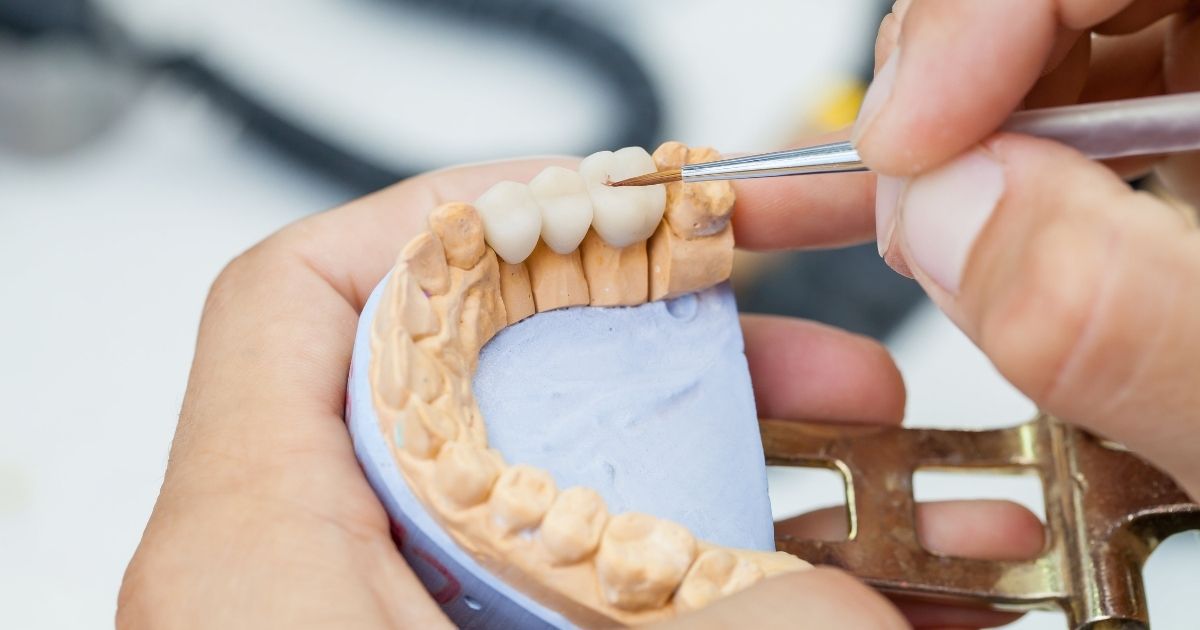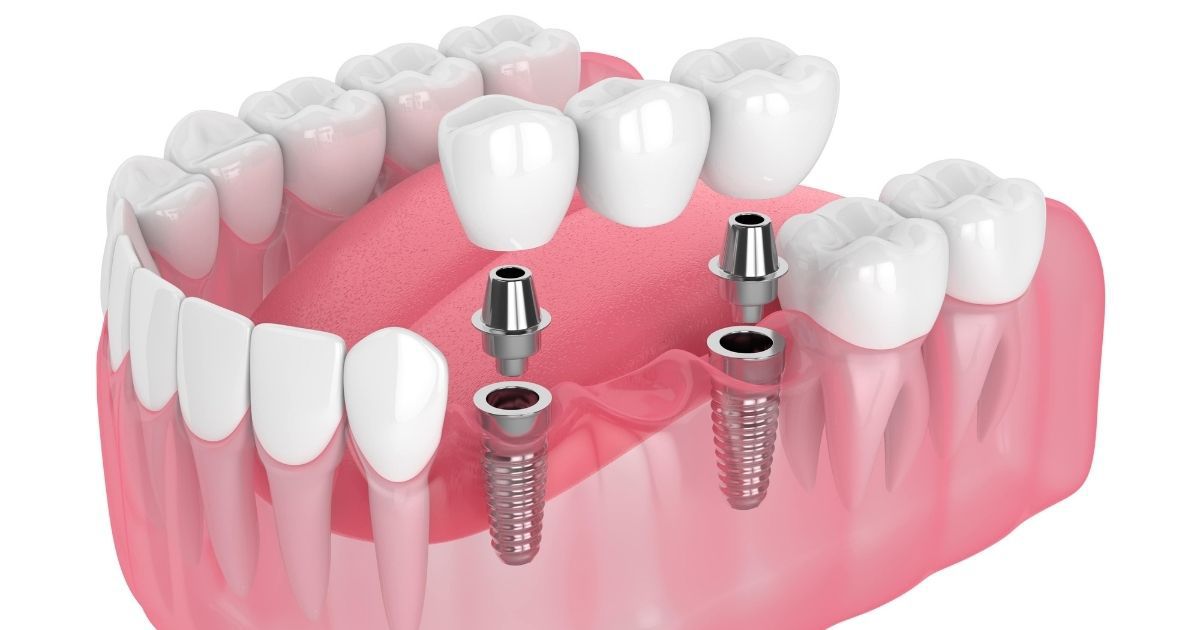Dental Bridges vs Dental Implants: How to choose
If you’re trying to decide between a dental bridge vs a dental implant to replace one or more missing teeth, the first step is to learn as much as you can about both options.
We’ve put together a guide comparing tooth implants vs dental bridges in all key areas, from how they look to what they cost, so you can make a more informed decision.
Reading time: 6 minutes

What are dental bridges and dental implants?
Dental bridges and dental implants are two of the most popular solutions for replacing missing teeth. Both can restore a full natural smile and proper chewing function, but they use completely different methods.
Dental bridges
A dental bridge is a prosthetic tooth that’s held in place by the surrounding teeth. It literally ‘bridges’ the gap created by a missing tooth, using crowns on the teeth on either side (also called abutment teeth) to ensure stability and a long-lasting result.
The traditional technique described above is just one type of dental bridge. Other variations include cantilever bridges which are only attached to one neighbouring tooth and Maryland bridges which use metal ‘wings’ to attach to teeth nearby, instead of crowns.
Dental implants
Dental implants are small metal screws that function like artificial tooth roots. They’re inserted surgically into the jawbone to provide a stable foundation for prosthetic teeth made of enamel, which are attached to the exposed part of the implant screw. This means that the natural tooth on either side of the false tooth replacement are not damaged like in bridge procedure, helping to preserve the healthy teeth nearby.
There are various types of dental implants available which can be used to replace individual teeth, multiple teeth, or even full rows of teeth. They include mini dental implants, all-on-4 implants, and all-on-6 implants. Each type has its own unique pros and cons, but all of them offer a long-lasting, high-quality result.
Dental bridges vs dental implants: An overview
To decide between dental bridges vs implants, you need to know how they compare to each other. Below, we’ve provided an overview of the key things to know about each tooth replacement option to help you understand their differences.
Procedure
The dental bridge procedure starts with the teeth adjacent to the gap getting filed down, preparing them for crowns. A dental bridge is fabricated as a single, continuous piece that includes the false tooth (pontic) and the crowns for the abutment teeth. This unit is made from a mould of the patient's mouth and is prepared outside of the mouth prior to being fitted, and attached under local anaesthetic.
Dental implants are fitted through a slightly more complex surgical procedure, again typically carried out under local anaesthetic. It involves making a small incision in the gum at the site of the tooth and affixing a dental screw to the jawbone beneath. A prosthetic tooth is then attached to the screw to sit above the gumline.
Look and feel
Dental bridges look mostly natural, but since they’re not embedded beneath the gum, the structure of the bridge can be visible between the false teeth and the crowns. They are generally comfortable after an initial period of adaptation.
Dental implants look practically indistinguishable from natural teeth, with the implant screw completely covered by a dental crown which is made to match your natural teeth. They also feel just like natural teeth after the initial post-surgery healing period.
Longevity
Dental bridges tend to last between 5 and 15 years on average, before needing replacement. This means they’re longer lasting than temporary dentures, but not quite as long-lived as dental implants.
Although their longevity depends on lots of factors, including how well dental hygiene habits are maintained, dental implants can last 30 years, or even longer. They’re extremely durable thanks to the stable hold provided by the implant screw.
Bone preservation
The prosthetic tooth in a dental bridge isn’t attached to the jawbone, just to crowns on the adjacent teeth. That means it doesn’t prevent bone loss in the jaw (called bone resorption) at the site of the lost tooth, which can advance at a rate of up to 25% in the first year after tooth loss.
Dental implants, on the other hand, reinforce the jawbone’s structure as the implant screw integrates with the surrounding bone material in a process called osseointegration. They also reintroduce stimulating chewing forces, which can prevent or slow down bone resorption.
Cost
Traditional dental bridges can cost anywhere between £300 to £1,000 per unit and usually require a minimum of 3 units per treatment so it´s important to consider the total price, depending on the materials used. Bridges that replace more than one missing tooth will generally be more expensive.
The cost of dental implants depends on several factors, including the type of implant and specific materials that are used. But patients can generally expect to pay between £1,500 and £3,000 for a single dental implant.
These may be covered by insurance in some instances, however, you should consult your provider as this varies a lot.
The pros and cons of dental implants vs bridges
The differences between dental bridges and dental implants mean each of the two options offers unique pros and cons compared to the other.
Dental implants
Pros
- Better longevity, capable of lasting up to 30 years
- More stability and durability against chewing forces
- Reinforce the jawbone and prevent bone resorption
- No requirement for crowns on adjacent teeth
- A more natural look and feel
Cons
- Generally more expensive up-front
- Implant surgery involves a longer recovery time
- Require a minimum jawbone density (or bone grafting procedure)
Dental bridges
Pros
- Generally cheaper up-front
- A quicker procedure and recovery period
- No requirement for bone grafting if jawbone density is low
Cons
- A relatively short lifespan, requiring replacement every 5-15 years
- Require healthy adjacent teeth to be crowned
- Doesn’t reinforce the jawbone or prevent bone resorption
Implant-supported bridge
An implant-supported bridge is a dental restoration used to replace multiple missing teeth. Unlike traditional bridges that rely on adjacent teeth for support, an implant-supported bridge is anchored by dental implants, which are titanium posts surgically placed into the jawbone.
Implant-supported bridges are ideal for those with several missing teeth in a row. The implants act as artificial tooth roots, providing a strong foundation for the bridge.
This type of restoration offers improved comfort and functionality compared to removable dentures. Additionally, implant-supported bridges do not require the alteration of healthy neighbouring teeth, preserving more of your natural dentition.

How to choose between dental implants and bridges
Whether dental implants or bridges will be best for you depends on many factors, including how many missing teeth you’re replacing, your jawbone density, conditions such as gum disease and your budget will all influence which option makes most sense.
Generally speaking, dental implants will provide you with a more robust, natural-looking, and longer-lasting outcome. But if keeping costs low in the short term is your priority, a dental bridge might appeal more.